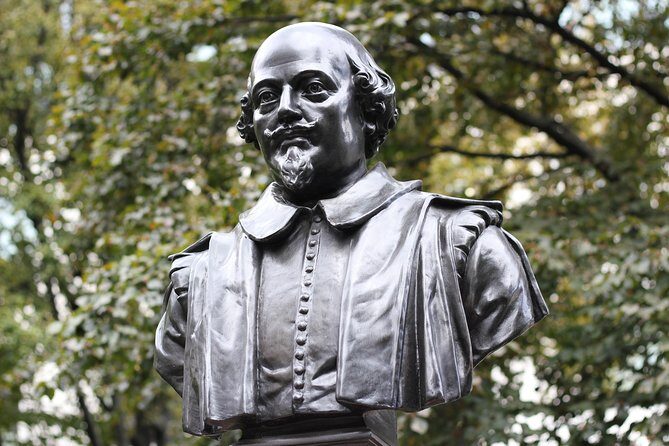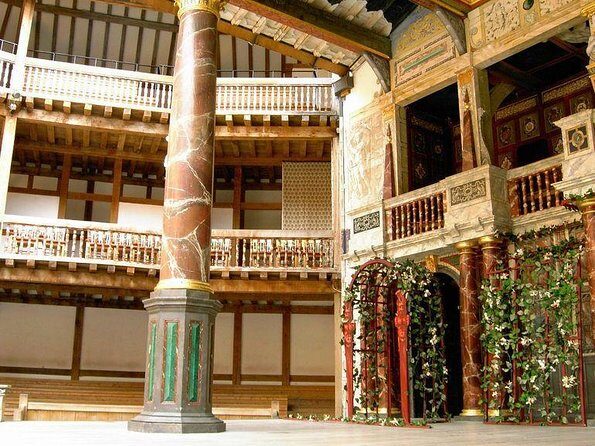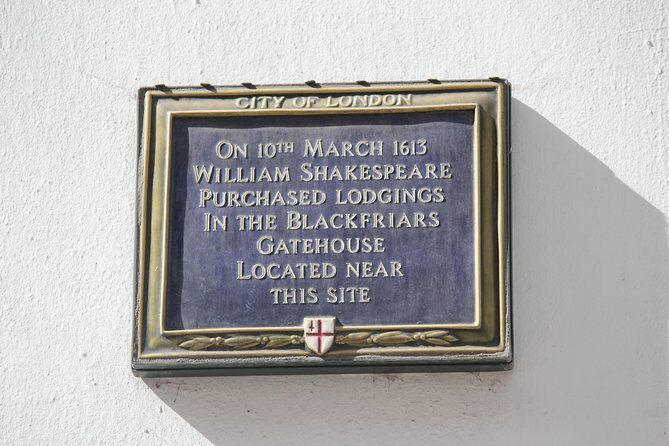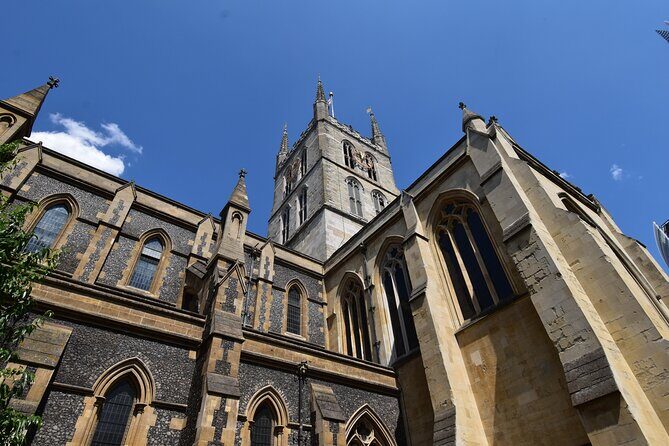Physical Address
304 North Cardinal St.
Dorchester Center, MA 02124
Physical Address
304 North Cardinal St.
Dorchester Center, MA 02124

Discover London through Shakespeare’s eyes on this private 3-hour walking tour, exploring historic sites, landmarks, and stories behind the Bard's life.
Walking through London’s historic streets with a focus on William Shakespeare offers a uniquely intimate way to connect with the Bard’s life and legacy. This private Shakespeare walking tour is crafted for those who want more than a surface-level visit, diving into the places Shakespeare himself knew, visited, and influenced. With an expert guide leading a small group—up to 15 people—this experience promises personalized insights, making it ideal for literature lovers, history buffs, or anyone curious about London’s cultural fabric.
One of the things we love about this tour is its carefully curated stops, from historic landmarks like St John’s Gate to the famous Globe Theatre. The tour is designed to blend storytelling with exploration, making the history of Shakespeare’s London accessible and engaging. However, it’s worth noting that the price, at around $248 for a group, could seem steep if you’re on a tight budget—yet, the personalized attention and depth of content make it worthwhile. It’s perfect for travelers who want a meaningful, authentic experience rather than just ticking off some sights.
This tour suits those with a moderate level of walking and an interest in history, theatre, or Shakespeare himself. If you’re eager to see London through the lens of its most famous playwright, with the reassurance of a knowledgeable guide, this private tour offers a well-balanced mix of storytelling, site visits, and cultural context.


If you enjoy exploring London on foot, these walking tours might also suit your style
Our journey begins at St John’s Gate, one of the few surviving places Shakespeare would have visited. This historic gate hosted the Master of Revels, the official responsible for licensing plays during Elizabethan times. Here, your guide will clarify how censorship worked in Shakespeare’s era, and why it persisted until 1968—affecting how Shakespeare’s plays were performed and perceived. This insight is crucial because it reveals how the restrictions of the time shaped the theatrical world Shakespeare was part of.
From the perspective of a visitor, standing outside this medieval gateway immediately connects you to the tightly controlled world of Elizabethan theatre. The guide’s explanation makes the history tangible, especially when you realize Shakespeare had to navigate this censorship to get his works performed.
Next, we stroll through Smithfield Market, a location directly referenced in Shakespeare’s plays, notably King Henry IV Part 2. It was a bustling hub in Shakespeare’s time, hosting annual fairs that drew Londoners from all walks of life. The guide raises the possibility that Shakespeare might have visited here with Ben Jonson, his contemporary and rival. Today, the Victorian renovation of the market still operates on the same principles, but the atmosphere would have been quite different in the late 16th and early 17th centuries.
This stop offers a fascinating glimpse into the vibrant life of London’s marketplace, providing context to the scenes Shakespeare wrote that depict lively urban gatherings.
St Bartholomew’s Hospital is the oldest working hospital in the world, founded in 1123. Its enduring presence offers a tangible link to Shakespeare’s time, as the hospital was standing during his lifetime. The guide will point out how early-modern hospitals like Bart’s and Bedlam Hospital influenced Shakespeare’s writing—characters and scenes inspired by real medical environments.
This stop adds a layer of understanding about the medical and social conditions of early 17th-century London, which often found their way into Shakespeare’s plays either directly or through character inspiration.
While Postman’s Park might seem unrelated, it offers insight into London’s commemorative culture, with a memorial to those who sacrificed themselves. It’s a quick pass-through but offers a moment to reflect on London’s layered history.
St Mary Aldermanbury Garden is particularly poignant, as it marks the site of a church where Shakespeare’s friends Henry Condell and John Heminge—key figures in Shakespeare’s publishing history—are buried. The guide will share stories about their role as shareholders in the original Globe Theatre and their efforts to preserve Shakespeare’s works.
For a more personal experience, these private London tours deliver individual attention
A highlight is the Guildhall Library, home to a preserved edition of the First Folio—the first collected edition of Shakespeare’s plays, published in 1623. We loved the meticulous care taken to safeguard such a vital piece of literary history. The library’s extensive collection offers a glimpse into London’s literary scene beyond Shakespeare, with over 200,000 titles spanning centuries.
Adjacent is Guildhall, London’s historic administrative center. Here, your guide will explain how Shakespeare’s social ambitions, like acquiring a London property and gaining a coat of arms, fit into the broader social fabric of Elizabethan and Jacobean London. The connection between politics, social status, and Shakespeare’s personal ambitions makes this stop particularly engaging.
As we approach St Paul’s Churchyard, the guide describes the significance of the First Folio and how it was sold here. You’ll get a picture of London’s thriving book trade and the cultural importance of Shakespeare’s works in early 17th-century England.
While standing outside the modern Blackfriars Theatre, your guide will describe the theatre’s history and its connection to Shakespeare’s later years. You’re encouraged to use your imagination here, visualizing the theatre and Shakespeare’s house—challenging to see today due to modern development but crucial to understanding his later career.
Passing the College of Arms, you’ll learn how Shakespeare’s father, John, was granted a coat of arms, symbolizing his rise in social status—an ambition Shakespeare himself shared. This stops highlights the social mobility Shakespeare achieved from humble beginnings.
The tour’s finale is outside the Shakespeare’s Globe Theatre, where your guide will explain the modern Globe’s history, its funding, and its significance in today’s theatrical landscape. The recent legal battles and restoration efforts underscore the enduring importance of Shakespeare’s legacy for London’s cultural identity.
Finally, the tour concludes at Southwark Cathedral, a site with deep ties to Shakespeare’s family and the Globe Theatre. Here, Shakespeare’s brother Edmund is buried, and the Cathedral’s Gothic architecture provides a fitting backdrop for reflection on Shakespeare’s impact and the enduring power of his works.
Our guide, Dewi, received glowing praise for his engaging storytelling, humor, and deep knowledge. As one reviewer noted, Dewi has a talent for painting vivid pictures of the past, making complex history accessible and fun. His insights into censorship, social ambitions, and London’s urban life added layers that you won’t find in typical sightseeing tours.
The tour’s strength lies in its ability to combine storytelling with real sites, making history alive rather than just observed from afar. With a small group, you’ll find it easy to ask questions and delve deeper into topics that pique your interest.

At approximately $248 per group (up to 15 people), the cost might seem high for some. However, considering the personalized guide, the depth of content, and exclusive access to sites like the Guildhall and Globe, it offers solid value for those seeking an immersive, well-informed experience. The tour lasts about three hours, which balances comprehensive coverage with manageable pacing.
What sets this tour apart is the focus on authentic locations connected directly to Shakespeare and the insider knowledge shared. It’s perfect for those tired of generic sightseeing and eager for a deeper understanding of London’s theatrical and social history.
This private Shakespeare walking tour is ideal for literature enthusiasts, history buffs, theatre lovers, or travelers who value a personalized experience. It suits those with a moderate level of walking and an interest in understanding London’s layered past through the lens of one of its most iconic figures.
If you want to see Shakespeare’s London beyond the tourist hotspots and hear stories that breathe life into the history, this tour offers a compelling, enriching journey.
In essence, this tour delivers a rich, detailed exploration of Shakespeare’s London with a knowledgeable guide who brings history to life with humor and clarity. The focus on authentic sites, combined with insights into censorship, social ambitions, and the theatre scene, provides a well-rounded understanding of the Bard’s environment.
While the price might be a consideration, the intimacy, personalization, and depth of content make it a worthwhile investment for those eager to connect with Shakespeare’s world in a meaningful way. It’s perfect for travelers who want more than just a standard sightseeing experience—it’s an educational adventure that leaves you with a new perspective on Shakespeare’s London.
This tour will suit anyone looking for a thoughtfully curated, engaging, and authentic walk through one of London’s most historically vibrant areas, with stories that stay with you long after the last step.

Is this tour suitable for all ages?
Yes, as long as you have a moderate physical fitness level. The tour involves about three hours of walking, but the pace is relaxed and suitable for most visitors.
What’s included in the tour price?
Guide fees are included. You’ll benefit from the personalized attention of your private guide, Dewi, who shares in-depth stories and insights.
Are tickets or entrance fees required for the sites visited?
Most stops, like St John’s Gate, Smithfield Market, and Southwark Cathedral, are free to explore with the guide providing context. The Guildhall Library and some other sites are also free of charge.
Can I choose the tour time?
Yes, you can select from a range of start times to fit your schedule, making it flexible for your day in London.
Does the tour include transport?
No, it’s a walking tour, so it’s suitable for those comfortable with moderate walking and standing.
How long does the tour last?
Approximately three hours, providing a thorough but manageable experience.
What if I need to cancel?
Cancellation is free if done at least 24 hours in advance. The full refund policy applies, making it a risk-free choice if your plans change.